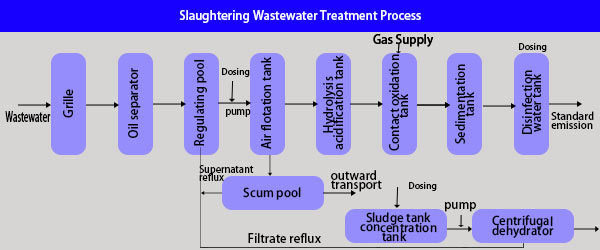Slaughterhouse Sewage Treatment
Category
零售价
市场价
重量
库存
隐藏域元素占位
- Overview
-
- Commodity name: Slaughterhouse Sewage Treatment
The treatment process of slaughterhouse wastewater mainly includes pre-treatment, air flotation machine treatment, advanced treatment, disinfection treatment, etc.
What is the slaughtering Wasterwater?
Slaughtering wastewater refers to the wastewater generated during the slaughtering process, mainly containing blood, oil, minced meat, animal hair, food and feces digested by the stomach, urine, etc. The wastewater is blood red with an unpleasant odor and contains a large amount of hair, meat shavings, etc. This type of wastewater has an impact on the environment and human health, and requires appropriate treatment.
Treatment Process
The wastewater enters the grid tank. After removing large suspended solids through the grid, it flows into the oil separation tank by gravity to remove some of the grease in the wastewater. After that, it flows into the regulating tank. When the water level in the regulating tank is at a high level, the water pump automatically starts: it is pumped into the integrated air flotation device to remove a large amount of small suspended solids and grease, and clean water enters the hydrolysis acidification tank through the overflow pipe. In the hydrolysis acidification tank, wastewater is decomposed and converted into various complex organic compounds such as methane and carbon dioxide through the action of chlorine resistant microorganisms, thereby converting harmful substances in the wastewater into harmless substances.

The wastewater flows through the hydrolysis acidification tank and then flows into the biological contact acidification tank. The contact chlorination method is a good chlorine biological removal process. Microorganisms grow in the form of biofilms and suspended in water, thus possessing the characteristics of both activated sludge and biofilter. In biological contact chlorination, organic carbohydrates are ultimately decomposed into CO and H20. The wastewater flows into the sedimentation tank after passing through the contact oxidation tank, which is a structure for solid-liquid separation of the effluent from the contact oxidation tank. The function is to remove aged biofilms and SS from water. The effluent from the sedimentation tank enters the disinfection tank and can be discharged up to standard after disinfection. The sludge from the sedimentation tank is discharged to the sludge concentration tank, where it undergoes aerobic digestion. The supernatant is returned to the regulating tank for treatment.
Slaughterhouse Wastewater Treatment Case

Keywords:
Messages
-
-
-
Wastewater treatment experiment results







